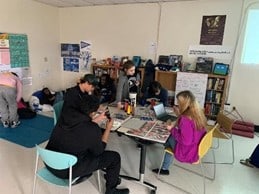 In the wake of the pandemic of 2020 and countrywide civil unrest that is being acknowledged worldwide, I ask this question: “What will it take to see our people as human?” More people are articulating an awareness of racial injustice that has had a long-overlooked history in the United States. As an educator, I ask a more specific question: “What will it take for teachers to see our students as human?” I ask this question because our nation’s teachers are 79% White, 9% Hispanic, 7% Black, 2% Asian (National Center for Education Statistics, 2017-2018). I argue that the majority of White teachers are American-born and have been taught some reasonable portion of American History. The American History curriculum teaches the glamorization of American domination over other cultures, commonly referred to as colonialization. The history of Black Americans often starts with slavery in which Black Americans were not considered fully human. These young teachers come into our nation’s classrooms with these ideas firmly embedded into their subconscious minds.
In the wake of the pandemic of 2020 and countrywide civil unrest that is being acknowledged worldwide, I ask this question: “What will it take to see our people as human?” More people are articulating an awareness of racial injustice that has had a long-overlooked history in the United States. As an educator, I ask a more specific question: “What will it take for teachers to see our students as human?” I ask this question because our nation’s teachers are 79% White, 9% Hispanic, 7% Black, 2% Asian (National Center for Education Statistics, 2017-2018). I argue that the majority of White teachers are American-born and have been taught some reasonable portion of American History. The American History curriculum teaches the glamorization of American domination over other cultures, commonly referred to as colonialization. The history of Black Americans often starts with slavery in which Black Americans were not considered fully human. These young teachers come into our nation’s classrooms with these ideas firmly embedded into their subconscious minds.
Having been educated myself in this same system, I view the world through the lens of those who were dominated and oppressed. My experience with the world is having my surface-level Black skin define who I am without people wanting to get to know the foundational content of my character.
Self-Reflection and Our Words
An important thing for teachers to do is to reflect on how their upbringing shapes their morals, values, and ways of being. We have our ways of doing things, and we judge others based on how they measure up to our standard of living. For example, we have biases or preferences of grocery stores, department stores, clothing stores, and thus have implicit biases of the people who frequent stores that are not our preference. When we make comments about our preferences for or against those stores, as in this example, people who are listening to us internalize the words and either feel validated or invalidated.
Think back to your childhood. What messages did you receive about race, ethnicity, gender roles, strangers, sexual orientation? Did you receive those messages fro m media like newspapers, television, radio, movies, social media? Or parents and other family members? What specific conversations did you have with your guardians and your peers? How did those messages influence your preferences? How much do those messages influence the choices you make in life? Another aspect of self-reflection that we should address is how we often look for evidence to confirm that our biases or preferences are valid. Teachers are no different. Teachers bring all of themselves into their workspaces. Words have power. We should all take heed to our “off the cuff” remarks. This leads to how we manage our classrooms.
m media like newspapers, television, radio, movies, social media? Or parents and other family members? What specific conversations did you have with your guardians and your peers? How did those messages influence your preferences? How much do those messages influence the choices you make in life? Another aspect of self-reflection that we should address is how we often look for evidence to confirm that our biases or preferences are valid. Teachers are no different. Teachers bring all of themselves into their workspaces. Words have power. We should all take heed to our “off the cuff” remarks. This leads to how we manage our classrooms.
Classroom Management
Early in my teaching career, I thought that the louder I screamed, the more compliant the students would be. I had to establish my domination of the classroom early. I had to show them who was in charge. I was taught that was how I should establish my authority in the classroom. I believed that. I taught that to preservice teachers. I now admit that I was wrong. The students would do things to push my buttons to make me scream and yell while they laughed.
Know that students are human beings and as such, they will have good days, bad days, and in-between days. Just as teachers have emotions, students have them as well. I saw a former student the other day, and he kept repeating that he missed me so much because I treated them as if they were “real.” He said other staff treated them as if they were “robots or something, but you treated us real.” Another student apologized for having a meltdown at school because there were things that happened at home that morning that we just did not understand. The student said he was just tired and wanted to be treated like a kid sometimes.
Our students will be different from us. That does not make their experiences wrong. They have needs and wants that are not ours. Teachers must be willing to acknowledge differences in skin color, abilities, languages, preferences, socioeconomic levels, etc. Teachers have the responsibility to be advocates. That advocacy in the classroom is closely aligned with culturally responsive practices. The most important aspect of being culturally responsive in the classroom is acknowledging human differences, and that includes acknowledging differences of colleagues as well as students.
 Teachers can advocate for children and families by writing emails, calling on their behalf, joining Parent-Teacher organizations, serving on city boards and commissions, volunteering with agencies that serve children and families. Simply being well-informed about school and public policy issues and sharing the information with friends, family members, and colleagues can help spread the word about important matters affecting students. In essence, advocacy is a continuous effort and you can do your part to rally against social, racial, and educational biases in a variety of ways. You just have to take that first step.
Teachers can advocate for children and families by writing emails, calling on their behalf, joining Parent-Teacher organizations, serving on city boards and commissions, volunteering with agencies that serve children and families. Simply being well-informed about school and public policy issues and sharing the information with friends, family members, and colleagues can help spread the word about important matters affecting students. In essence, advocacy is a continuous effort and you can do your part to rally against social, racial, and educational biases in a variety of ways. You just have to take that first step.
















